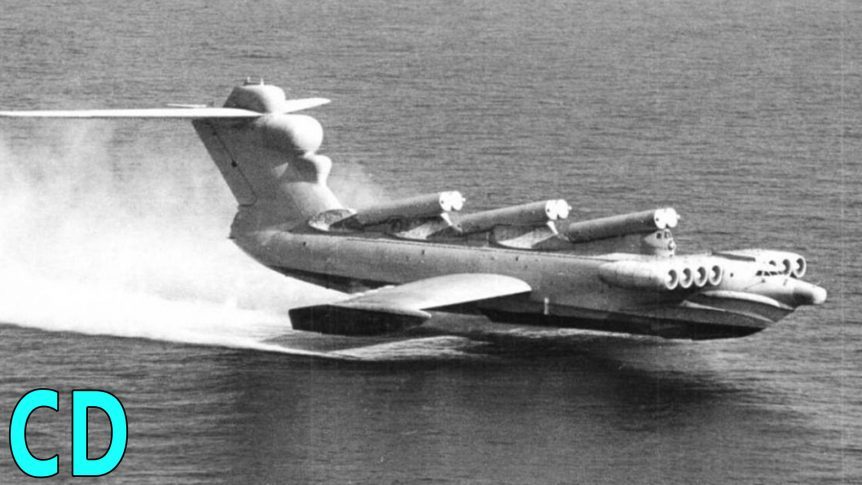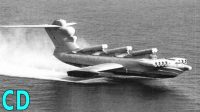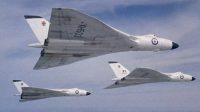In 1967, whilst the U.S’s first spy satellite ‘Corona’ was busy photographing the Soviet Union, something unusual was spotted. It looked like a massive plane, but its wings were too short, it also sported the Soviet Navy Flag on it fuselage, so what was it? Maybe an unfinished aircraft or some new design of amphibious vehicle.
This leviathan was, in fact, the ‘Ekranoplan’, a new class of what is now known as a ‘ground-effect’ vehicles that made use a phenomenon that occurs when a wing is travelling close to the ground.
The ‘Ekranoplan’ was the brainchild of Rostislav Alexeyev, a Russian designer who began his career working on high-speed hydrofoils. Through the 1950s he developed a number of successful ships, rising to lead the Central Hydrofoil Design Bureau in the city of Gorky (now Nizhniy Novgorod) on the River Volga. But still, his thirst for speed led him to his most famous idea: to lift the hydrofoil’s fins out of the water entirely.
Alexeyev’s innovation was to use this ‘ground effect’ phenomenon and he envisioned a huge vehicle with the capacity of a ship but the speed of an aircraft.
The ground-effect works when a wing is provided with extra lift by the “cushion” of air trapped between the surface below and the wing and enables a combination of greater aircraft weight for less power and/or greater fuel efficiency.
However, his designs would cost a lot of money to build: a tough sell when resources were thinly spread in Soviet Russia. However, if a military use for the Ekranoplan could be found, then the project’s models could be scaled up.
The Gorky engineers drew up plans for a prototype Ekranoplan that would be large enough to transport hundreds of troops, or bring a battery of missiles in range of enemy territory. The benefits for the Navy were obvious: the Ekranoplan would travel at high speed just above the sea but below the enemy radar, it would also be immune to mines, torpedoes and anti-submarine nets.
In 1960 Alexeyev attended a Communist party meeting where Khrushchev was in attendance, and immediately captured the imagination of the Soviet Premier. Khrushchev saw the Ekranoplan as a way to face up to America’s mighty Aircraft Carriers and championed Alexeyev’s design bureau. Khrushchev would later boast that the USSR had ‘boats that could jump over bridges’, but everyone assumed that he was joking.
In the early 1960s everything about the ‘Ekranoplan’, including its name, was classified. The project was known as ‘steamboat’, which must have seemed appropriate as the prototype took shape around a boat-like hull. The first working model was known as ‘KM’ or ‘Korabl maket’ meaning simply: ‘Prototype ship’.
Although the ‘KM’ was hidden in a wooden casing and only moved at night, the strange shape was spotted in images from the American ‘Corona’ reconnaissance satellite. The Defence Intelligence Agency puzzled over what it could be: the squat wings didn’t seem capable of lifting an aircraft of that size. In fact, they were so concerned as to what it might be that the CIA was even going to use a special remote-controlled drone project called AQUILINE that originally been developed to spy on the Chinese nuclear program but its unreliability forced them to abandon the idea. Because of the letters ‘KM’ painted on its back, they gave it the nickname ‘Kaspian Monster’, but it became commonly known as the ‘Caspian Sea Monster’ by those in the west.
On October 16th, 1966, ‘KM’ was prepared for its maiden flight. Alexeyev himself was on board, against usual rules which dictated that designers should not ride in test vehicles. The giant Ekranoplan lifted from the waves and accelerated to 400km/h with the power of its eight huge turbojet engines at the front. Then the roar of its engines quietened, and ‘KM’ cruised just as Alexeyev had imagined. The eight engines not only provided the forward thrust, their exhaust was angled down to direct air under the short wings to give them an extra air cushion to ride on.
During that fifty minute flight, the fuselage flexed and rolled: an issue that would be later rectified by strengthening the body panels. But the Ekranoplan worked: they had proved that their Sea Monster could fly.
However, the political tides of the Soviet Union were about to turn. Khrushchev was ejected from office in 1964, and replaced by Leonid Brezhnev, who was deeply sceptical of oversized concepts like the ‘KM’.
Alexeyev and his engineering team went to Brezhnev to present their plans directly: but the Premier was unimpressed. At the end of the presentation, his only comment was about the lunch.
Under the new administration, Alexeyev’s dream of a fleet of giant Ekranoplans began to fade. However, his Central Hydrofoil Design Bureau was given the go-ahead to build a smaller transport vehicle based on the technology. Called the ‘Orlyonok’, or ‘Baby Eagle’, the first military Ekranoplan was still a huge beast, 80% as long as a Boeing 747 jet, and able to move 140 marines or 2 loaded Armoured Personnel Carrier vehicles.
Alexeyev’s Design Bureau also developed another military Ekranoplan: this time an ‘Aircraft Carrier Killer’ called ‘Lun’, (meaning ‘Harrier’). At 280 tons and 74 metres long, ‘Lun’ was equipped with six ‘Mosquito’ rocket launchers along its dorsal edge, which could engage an enemy ship from 90 kilometres away.
However, the Ekranoplan required considerable skill to operate and keep it at the optimal height of 20 meters above the water. Pilots also reported fatigue from constantly scanning the oncoming waves for small boats. In 1975 during a test flight of one of the ‘Orlyonok’ vehicles, the tail and rear engine broke off, in rough seas. Luckily, Alexeyev was on board, and took control from the pilot, quickly engaging the remaining engines to land the crippled Ekranoplan on the shore. Although he had saved the crew, Soviet Military chiefs blamed Alexeyev for the accident and removed him as Chief designer of the Bureau. Alexeyev’s independent character had put him at odds with the Soviet establishment, and within years he was demoted again, and eventually side-lined.
Alexeyev withdrew from his research, he spent long days sailing, battling storms in an elemental struggle with the sea. In his final years, he despaired, telling his daughter: ‘I didn’t achieve what I wanted.’ In 1980, aged 63, he died of injuries he received in an accident while testing a new Ekranoplan which was to be shown at the 1980 Olympics in Moscow.
That year would also see Alexeyev’s greatest invention laid to rest. On December 15th, the ‘KM’ prototype, by this time in poor condition, launched for a test flight. The inexperienced pilot reportedly attempted take-off without engaging full power, and the Sea Monster crashed, sinking in 20 metres of water. Although the giant tail and stabilizer protruded above the water for a time, the first Ekranoplan was too massive to be recovered, and remains in the Caspian Sea to this day, lurking beneath the waves.
In 1984, one of the ekranoplans main supporters the Minister of Defence, Dmitriy Ustinov died and soon after funding was removed from the from the project. In 1991 the Soviet Union collapsed and the remaining ekranoplans were abandoned. The massive Lun ended up in Kaspiysk where it is still there today, while one of the last Orlyonok’s was moved to the Russian Navy Museum in Moscow.
Although the Soviets and later Russians where the main proponents of the ground effect vehicles, other countries including South Korea, China and Germany have also built their own versions in varying sizes, nothing has been on the scale of the original Ekranoplans.
In 2002, Boeing in the US unveiled a monster-sized design called the Pelican which would have been the biggest plane ever built. The length of a football field with a wingspan of 152 meters and carrying capacity of 1400 tons, it would fly at 20,000ft over land but over open seas, it would fly at just 20 feet to use the ground effect to make it more efficient. However, since its unveiling nothing more has been heard about the Pelican.
So what do you think of the ekranoplans, a possible future transport system or technological dead end, let me know in the comments?





